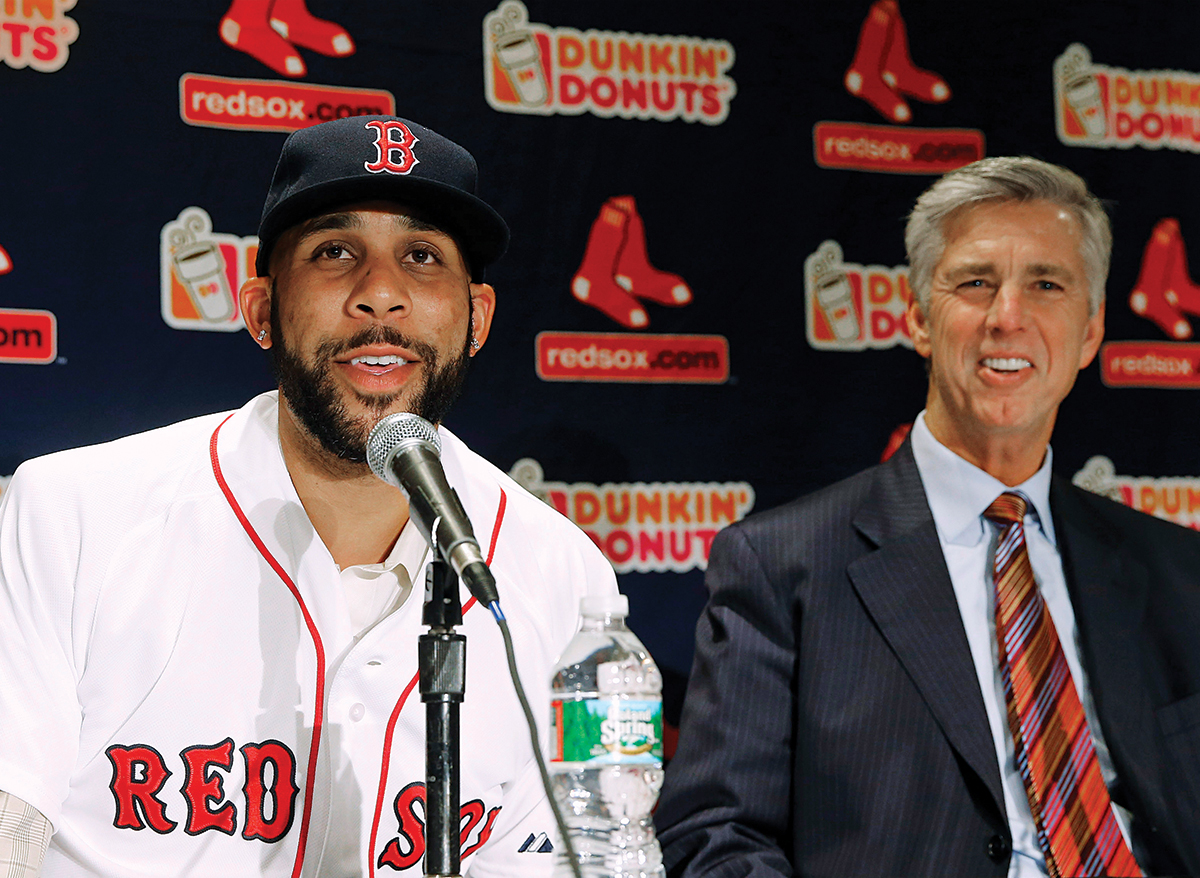The Rebirth of the Red Sox

Winslow Townson/AP Images
For Red Sox fans and followers, a simple piece of advice: Stop bitching about the money.
When the team signed left-handed ace David Price in December to a staggering $217 million contract—the largest ever for a major league pitcher—Red Sox Nation was left stunned and wondering: How did this happen? Price “was always bound to sign the richest contract ever for a pitcher,” the Herald scoffed. “But the Red Sox never needed to be the ones to give it to him.” After all, that’s Yankees money. That’s not how we do things here. For proof, look no further than former Red Sox president and CEO Larry Lucchino. Just two years ago, a reporter famously asked him about the similarities between the Red Sox and their archenemies in New York. “We’re very different animals,”Lucchino crowed, adding, “I’m proud of that difference. I always cringe when people lump us together. Other baseball teams sometimes do that. They are still…relying heavily on their inimitable, old-fashioned Yankees style of high-priced, long-term free agents. And I can’t say that I wish them well, but I think that we’ve taken a different approach.”
For years, the Red Sox have been trapped in a small-market mentality, practically allergic to signing star players in their primes to blockbuster contracts. Time and again, the team has taken itself out of the running for marquee talent, afraid of crippling their future by spending too much coin on a single player. But why? Maybe it’s the Sox’s tortured history of losing that makes it hard to shake that scrappy underdog mentality. Maybe the team, like most of its fans, likes to see itself as a frugal New Englander. Whatever the reason, I only have this to say: poppycock. Horse feathers. Bull crap. Open your eyes: Sox owner John Henry could buy and sell any member of the Steinbrenner family. The Red Sox are the big guys, the rich kids, the bullies of the major leagues. Or at least they should be, and the sooner we all accept that, the better off we all are.
Ever since their 2010 third-place finish in the American League East, the Red Sox have seemingly remained in an identity crisis, unable to decide whether they are a player-development operation with an eye on building from within or a big spender whose financial recklessness knows no bounds. Somehow, in the middle of it all, they won a World Series in 2013, a title that, in retrospect, was the professional sports equivalent of a one-night stand with a psychotic supermodel—exhilarating in the short term, but full of damning repercussions in the long run.
For one thing, it reinforced the notion (not the reality) that the team could win with a responsible financial approach. After their improbable championship win, when the Red Sox were feeling their oats and puffing out their chests, Henry and Sox officials essentially bragged about their thrifty business philosophy when it came to signing players. “Virtually all of the underpaid players [in the league] are under 30,” Henry told Bloomberg Businessweek, “and virtually all the overpaid players are over 30.” Many teams, he added, foolishly “continue to extravagantly overpay for players above the age of 30.”
The following 2014 season, the Red Sox went all in on Henry and Lucchino’s nonsense. When it came time to re-sign 30-year-old starting pitcher Jon Lester, who’d developed into the ace of the staff after playing in the minors for the Sox organization, Henry and Lucchino initially served up a laughable $70 million contract over four years. It didn’t take long for Lester to make a deal with former Red Sox executive Theo Epstein, of the Chicago Cubs, for far more than double the offer. As a result—without Lester or another front-end starting pitcher—the Red Sox fumbled to consecutive last-place finishes in 2014 and 2015.
It’s easy to understand why fans think the Red Sox are running around in circles with their heads cut off. After all, they low-balled Lester and then signed Price—a similar 30-year-old left-handed starter—for $62 million more than Lester ultimately received. So why should we be optimistic entering 2016?
Slowly, the Red Sox are undergoing a change and are achieving something they haven’t had since the glory days of 2007: balance. Once again, the team has patiently developed young players, this time guys such as Xander Bogaerts, Mookie Betts, and Blake Swihart. But now they are also thinking like a big-market club, spending their enviable resources by signing Price and trading for high-priced closer Craig Kimbrel as bookends to a pitching staff badly in need of powerful arms. I’ll say it again: development and big spending. Balance. And if you look closely at this year’s team with the right sort of eyes, it appears that Henry’s new president of baseball operations, Dave Dombrowski—a proven winner in Florida and Detroit who has a reputation for developing talent and handing out huge paychecks—is finally piecing together the next potentially great Sox team.


